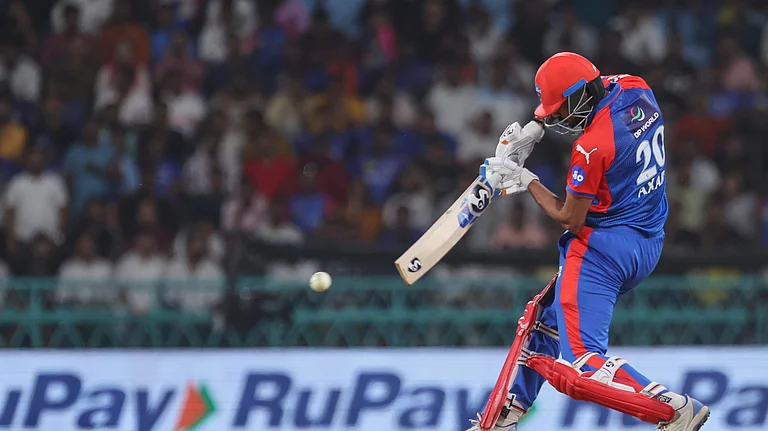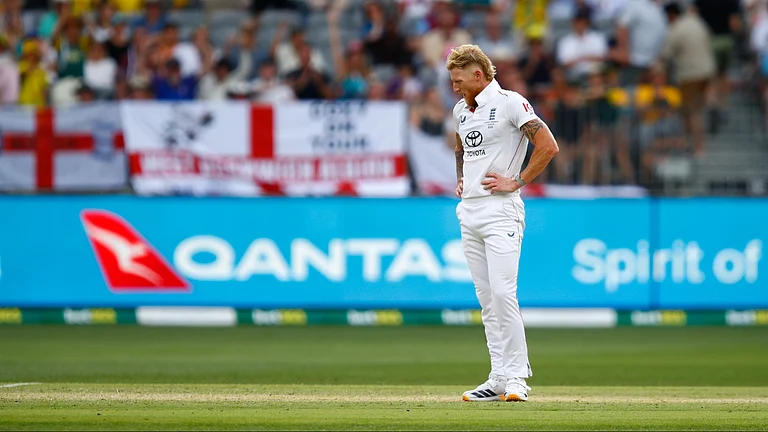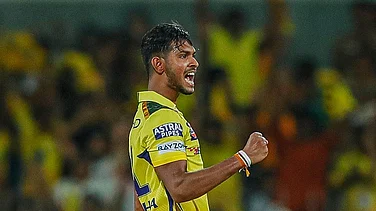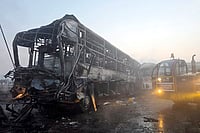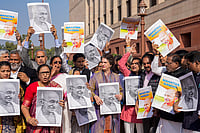Dhanraj Pillay gets misty-eyed as he talks about former hockey great Mohammad Shahid. Says the ace forward, recounting a recent encounter at a Sahara India-organised tournament in Delhi: "Shahidji had tears in his eyes talking to me and Mukesh Kumar. He said, 'had you two been playing during my time, no team would have been able to touch us. I wish I was young enough to play with you two'." Pillay himself returns the compliment: "Hockey never saw nor will see another player like Shahid."
Pillay's own mission in the coming Atlanta Olympics: win the gold for India and Shahid. And if things stand as they are, hockey is the only discipline where the Indians have any hope of striking a medal. Says A.S.V. Prasad, chairman, Sports Authority of India (SAI), and executive director at the Netaji Subhas National Institute of Sports (NIS) at Patiala: "Except for hockey, it's a bleak scenario at the moment. With the entry of the Russian breakaway republics in the Asian arena, we are struggling even to achieve Asian standards."
While the hockey, shooting, table tennis, judo, boxing, badminton and lawn tennis squads for Atlanta have been announced, the other disciplines for which trials are yet to take place and selections made are athletics, weightlifting, and equestrian events. Apart from hockey, the only disciplines where a dark horse could streak ahead are shooting and boxing. The two names: Mansher Singh in trap shooting and Gurucharan Singh in the light heavyweight division (75-81 kg).
While Mansher is the only shooter to have qualified directly, his temperament is thought of as suspect. Says Prasad: "Wherever he has won, he has done it in a loose field. He has never come good under pressure." In the recent World Cup at Atlanta as a warm-up to the Olympics, Mansher didn't even make it to the final round. The event was won by Zao Zhang of China, who shot 147 out of the 150 possible. While the world record in clay pigeon shooting is 149 out of 150, Mansher's best in Delhi has been 146. Says he: "I am trying to peak around the Olympics." He is currently training in Milan, Italy, where he will participate in another World Cup.
Jaspal Rana, the other Indian shooter who is making it to Atlanta on a wild card, is, self-admittedly, just going for the experience. Says Rana: "My real target is Olympics 2000." Participating in the air pistol and free pistol events, Rana is handicapped because his main event, centre fire, is not an Olympic discipline. In the just-concluded World Cup at Atlanta, Rana did make it to the final round. But the chasm is too big to hope for anything spectacular—Rana's best in the event is 562 which he shot in the recent Commonwealth championship and which is 18 short of the world record.
Boxing, though, might hold out a silver lining, if (and that's a big if) the boys have a lucky draw. While three boxers—Devender Thapa (20), Lakha Singh (27), and Gurucharan Singh (20)—have made it to the squad, it's only Gurucharan that chief boxing coach Gurbax Singh Sandhu picks as someone who might give a good showing. Says Sandhu: "I won't be surprised if he does. He is sincere in training and has a good build. In fact, one of our athletic coaches said that if I loaned him to athletics, he could make him a great decathlon prospect."
Gurucharan, in fact, proved his mettle under pressure in the Asian championships at Manila this January against the reigning Iranian champion in his weight class. He got a count within 30 seconds of the first round but came back strongly to win the gold despite vociferous support for the Iranian. Says Sandhu: "I am confident that he can take care of any Asian or African opposition. He has the temperament to go in for the kill." The crunch, according to Sandhu, comes in sheer bout experience. Gurucharan has fought just 13 bouts. The American and European opponents he is likely to face will have 70-plus bouts to their credit. Also, Sandhu is seriously hampered by the lack of latest video clippings. Says he: "All I have is clips which date back to Seoul, 1988."
The entire camp is shifting to Cuba for a month in June, where the boxers will be concentrating on pure technique. Right now, Sandhu is putting them through a cycle of high loads to tone up their physique and hardening their emotional stability for a bout. What Sandhu is missing is the presence of V. Devarajan, the boxer who is being hailed in the UK—where he recently won his first two bouts after turning professional—as 'a star from the East'. Says Sandhu: "He would have been a hot medal prospect."
Another contingent showing promise is of the eight shortlisted weightlifters, in training at the SAI centre at Bangalore since March. For the first time, the Indian Weight Lifting Federation (IWF) has snatched five places for desi lifters in the Olympics. India had come 23rd among the 75 countries that participated in the World Championship in Gangju, China, last November. Says Anil Mondal, chief coach of the Indian weightlifters: "We've secured five places but we aren't sure how many lifters will be cleared by the Government."
The selection trials are scheduled for May 30 and Mondal expects good performances in the 54 kg, 59 kg and 64 kg classes in that order. He also singles out B. Adishekhar (54 kg), T. Mutthu (54 kg) and Satish Rai (76 kg) as the lifters expected to do particularly well in the snatch category. While Adishekhar is the only one to have represented India at Barcelona in 1992—he stood 10th—he was joined by Mutthu and Rai at the World Championship. Adishek-har improved his position to number nine in China but Rai was placed 20th. Though realistic about India's chances, or the lack of it, Mondal is unhappy over the division of training camps between Patiala and Bangalore. Says he: "I don't know what is happening there."
Table tennis players Chetan Baboor and A. Radhika, however, have been spared of uncertainty by qualifying for Atlanta through the pre-Olympic qualifying rounds for Asia held in Japan this March. Baboor was placed ninth among 48 Asians who jostled for the 12 men's singles places allotted to Asia while Radhika topped her group in the second leg of the qualifier to get a place in the ladies singles field. The two have been training since early May at Bangalore under the eyes of Korean coach N. Phung. Says he: "I want to improve the players technically. It's too early to predict how well they will do in Atlanta but I am aiming at their being placed in the top 32 in the games. They need to intensify their attack and top spinning."
Radhika is excited at the prospect of playing at Atlanta. But ranked 150 in the world, she is realistic about her chances: "Of course, I won't get a medal. But I will be happy if I make it past the first two rounds. Technically, I am concentrating on my forehand as it's my strong point."
What's really in bad shape, though, is Indian athletics and wrestling. This is the first time that no Indian wrestler has qualified for the Olympics—a fact that led to chief coach Raj Singh's resignation. Says Ho Kwangil, the Korean wrestling coach who the SAI has brought over: "Indian wrestlers lack in both strength and technique. Though wrestling is popular in India, the traditions surrounding it are not conducive to international competition." But this time the team had virtually no training before the Asian games, with selection trials alone being held just one month before the championship. Also, as Kwangil says, the Asian field has now become stronger with the induction of countries like Uzbekistan and Kazakhstan. About training problems, Kwangil is very vocal about two—the lack of an air-conditioned training hall and the many mosquitoes bothering his wrestlers in the hostel rooms at Patiala.
Though athletic trials are to be held in early July in Bangalore, the current list of hopefuls has just six members, of which four are from the women's 400 m relay team. Middle-distance runner Bahadur Prasad and discus thrower Shakti Singh, 34, complete the list. Shakti is the first Indian thrower to have crossed 60 m in the discus and 19 m in the shotput. While his best discus throw is 61.72 m, the world record stands at 74.5 m. Says Shakti: "A throw of 60 plus is enough to get you in the final round of 12." But that seems a stiff chance because even the Asian record stands at 65.76 m in the name of Chinese Li Shaoji.
Says chief athletics coach and former India shotput champion Bahadur Singh: "Shakti has good technique but lacks in power. We are concentrating on a power regimen for him." Shakti himself cites his age as a limiting factor. Says he: "I started very late. At the age of 22. By that time European throwers are already five-six years into the sport." Currently, hampered by a knee injury which is forcing him to concentrate just on upper body exercises, Shakti is also skipping Europe for fear of aggravating his knee.
The women's relay team and Bahadur Prasad left for a 25-day stint in Europe in mid-May. Says Singh about the relay team: "We are concentrating on the qualifying marks. All I can say is that we will try to be good in this field. We will try to better the Asian record." The best result of the women's quartet so far has been in the Asian Track & Field championship at Jakarta where they clocked 3:32 minutes for the silver, two seconds slower than the Chinese team. Though the Indian four haven't been decided as yet, indications are that the final four are most likely to be P.T. Usha, Shiny Abraham, Rosa Kutty and Jyotirmoyee Sikdar.
The hockey team also is not totally without problems. Penalty corner conversion, the subcontinent's proverbial Achille's heel, is poor. Says Indian captain Pargat Singh: "What we need is the ability to hit and scoop the ball at the same time to achieve a better conversion rate. For instance, Anil Aldrin is a good hitter but a poor scooper whereas Baljit Dhillon is good at scooping but a poor hitter." With goalkeepers tending to lie on the ground during penalty corner shoots, the ability to keep him guessing is vital. The team is also in search of a good inside right to relieve the pressure on Dhillon who, on current shape, is not good enough to last full time.
A good team spirit and a rolling confidence has, however, built up as Pargat's team got international exposure in probing tours to Europe and Atlanta. Says Pillay: "In 1992 at Barcelona, we committed the mistake of playing with our full strength against the teams in our groups. They made our video clips and that worked against us. We didn't commit the same mistake this time around." The countries in group A, in which India is placed, include Argentina, Germany, US, Spain and Pakistan. With only two countries to make it to the next phase, India will be jostling in the main with Germany and Pakistan for a place in the semi-finals.







